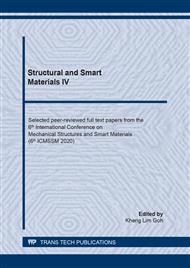[1]
W. B. Rowe, Principles of modern grinding technology: William Andrew, (2013).
Google Scholar
[2]
J. Palmer, H. Ghadbeigi, D. Novovic, and D. Curtis, An experimental study of the effects of dressing parameters on the topography of grinding wheels during roller dressing,, Journal of Manufacturing Processes, vol. 31, pp.348-355, (2018).
DOI: 10.1016/j.jmapro.2017.11.025
Google Scholar
[3]
F. Klocke, J. Thiermann, and P. Mattfeld, Influence of the dressing process on grinding wheel wear,, Production Engineering, vol. 9, pp.563-568, (2015).
DOI: 10.1007/s11740-015-0606-y
Google Scholar
[4]
D. D. Mohite and S. Jadhav, An Investigation of Effect of Dressing Parameters for Minimum Surface Roughness using CNC Cylindrical Grinding Machine,, IJREAS, vol. 6, pp.59-68, (2015).
Google Scholar
[5]
L. A. Tung, V. N. Pi, V. T. Lien, T. T. Hong, L. X. Hung, and B. T. Long, Optimization of dressing parameters of grinding wheel for 9CrSi tool steel using the taguchi method with grey relational analysis,, in IOP Conference Series: Materials Science and Engineering, 2019, p.012030.
DOI: 10.1088/1757-899x/635/1/012030
Google Scholar
[6]
H. X. Tu, T. T. Hong, N. T. T. Nga, J. Gong, and V. N. Pi, Influence of dressing parameters on surface roughness of workpiece for grinding hardened 9XC tool steel,, in IOP Conference Series: Materials Science and Engineering, 2019, p.012008.
DOI: 10.1088/1757-899x/542/1/012008
Google Scholar
[7]
M. Novák, N. Naprstkova, and H. Kasuga, Influence of grinding wheel dressing on the roughness of final surface and cutting force during GGG60 grinding,, in Key Engineering Materials, 2016, pp.218-223.
DOI: 10.4028/www.scientific.net/kem.686.218
Google Scholar
[8]
A. Azizi, S. M. Rezaei, and A. Rahimi, Study on the rotary cup dressing of CBN grinding wheel and the grinding performance,, The International Journal of Advanced Manufacturing Technology, vol. 47, pp.1053-1063, (2010).
DOI: 10.1007/s00170-009-2227-0
Google Scholar
[9]
H. Baseri, S. Rezaei, A. Rahimi, and M. Saadat, Analysis of the disc dressing effects on grinding performance—part 2: effects of the wheel topographical parameters on the specific energy and workpiece surface roughness,, Machining Science and Technology, vol. 12, pp.197-213, (2008).
DOI: 10.1080/10910340802067429
Google Scholar
[10]
X. Chen, Strategy for the selection of grinding wheel dressing conditions,, Liverpool John Moores University, (1995).
Google Scholar
[11]
T. Buttery, A. Statham, J. Percival, and M. Hamed, Some effects of dressing on grinding performance,, Wear, vol. 55, pp.195-219, (1979).
DOI: 10.1016/0043-1648(79)90153-4
Google Scholar
[12]
M. Rabiey, C. Walter, F. Kuster, J. Stirnimann, F. Pude, and K. Wegener, Dressing of hybrid bond CBN wheels using short-pulse fiber laser,, Journal of Mechanical Engineering, vol. 58, pp.462-469, (2012).
DOI: 10.5545/sv-jme.2011.166
Google Scholar
[13]
I. Aleksandrova, Optimization of the dressing parameters in cylindrical grinding based on a generalized utility function,, Chinese Journal of Mechanical Engineering, vol. 29, pp.63-73, (2016).
DOI: 10.3901/cjme.2015.1103.130
Google Scholar
[14]
G. Trmal and H. Kaliszer, Optimization of a grinding process and criteria for wheel life,, in Proceedings of the Fifteenth International Machine Tool Design and Research Conference, 1975, pp.311-315.
DOI: 10.1007/978-1-349-01986-1_37
Google Scholar
[15]
T. Yu, A. F. Bastawros, and A. Chandra, Experimental and modeling characterization of wear and life expectancy of electroplated CBN grinding wheels,, International Journal of Machine Tools and Manufacture, vol. 121, pp.70-80, (2017).
DOI: 10.1016/j.ijmachtools.2017.04.013
Google Scholar
[16]
T. Hwang, C. J. Evans, E. P. Whitenton, and S. Malkin, High speed grinding of silicon nitride with electroplated diamond wheels, part 1: wear and wheel life,, J. Manuf. Sci. Eng., vol. 122, pp.32-41, (2000).
DOI: 10.1115/1.538908
Google Scholar
[17]
T. Hwang, C. J. Evans, and S. Malkin, High speed grinding of silicon nitride with electroplated diamond wheels, part 2: wheel topography and grinding mechanisms,, J. Manuf. Sci. Eng., vol. 122, pp.42-50, (2000).
DOI: 10.1115/1.538909
Google Scholar
[18]
J.-S. Kwak and M.-K. Ha, Evaluation of wheel life by grinding ratio and static force,, KSME international journal, vol. 16, pp.1072-1077, (2002).
DOI: 10.1007/bf02984426
Google Scholar
[19]
X. Chen, W. Rowe, and R. Cai, Precision grinding using CBN wheels,, International Journal of Machine Tools and Manufacture, vol. 42, pp.585-593, (2002).
DOI: 10.1016/s0890-6955(01)00152-3
Google Scholar
[20]
J.-S. Kwak, Application of Taguchi and response surface methodologies for geometric error in surface grinding process,, International journal of machine tools and manufacture, vol. 45, pp.327-334, (2005).
DOI: 10.1016/j.ijmachtools.2004.08.007
Google Scholar
[21]
V. Pi, A. Lu, L. Hung, and B. Long, Cost optimization of surface grinding process,, J. Environ. Sci. Eng., vol. 5, pp.606-611, (2016).
Google Scholar
[22]
V. N. Pi, L. A. Tung, L. Hung, and N. Ngoc, Experimental determination of optimum exchanged diameter in surface grinding process,, J. Environ. Sci. Eng. A, vol. 6, pp.85-89, (2017).
DOI: 10.17265/2162-5298/2017.02.004
Google Scholar
[23]
S. Shaji and V. Radhakrishnan, Analysis of process parameters in surface grinding with graphite as lubricant based on the Taguchi method,, Journal of Materials Processing Technology, vol. 141, pp.51-59, (2003).
DOI: 10.1016/s0924-0136(02)01112-3
Google Scholar
[24]
L. Barczak, A. Batako, and M. Morgan, A study of plane surface grinding under minimum quantity lubrication (MQL) conditions,, International Journal of Machine Tools and Manufacture, vol. 50, pp.977-985, (2010).
DOI: 10.1016/j.ijmachtools.2010.07.005
Google Scholar
[25]
G. Manimaran and R. Venkatasamy, Influence of cryogenic cooling on surface grinding of stainless steel 316,, Cryogenics, vol. 59, pp.76-83, (2014).
DOI: 10.1016/j.cryogenics.2013.11.005
Google Scholar
[26]
T.-V. Do and Q.-C. Hsu, Optimization of minimum quantity lubricant conditions and cutting parameters in hard milling of AISI H13 steel,, Applied Sciences, vol. 6, p.83, (2016).
DOI: 10.3390/app6030083
Google Scholar
[27]
M. S. Phadke, Quality engineering using design of experiments,, in Quality control, robust design, and the Taguchi method, ed: Springer, 1989, pp.31-50.
DOI: 10.1007/978-1-4684-1472-1_3
Google Scholar


